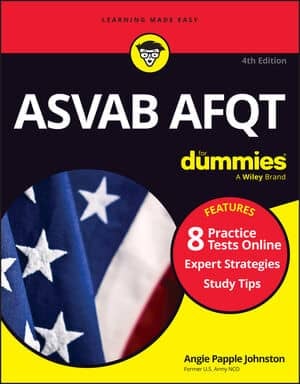As soon as the test starts, write down what you’re likely to forget
You can’t bring your own scratch paper to the test, but the test proctors will give you as many sheets of scratch paper as you want. Not only is your scratch paper useful to take the place of the calculator you’re not allowed to use, but you can also use it to write notes at the very beginning of the test — things that you’re worried you may forget.Read all the answer choices before deciding
I think those people who write the ASVAB questions must go through a special course about being tricky. Many of the answer choices given on the ASVAB are “close but no cigar.” In other words, these tricksters often try to pull a fast one over on you with an incorrect answer that’s almost correct but not quite.The best defense against this type of trickery is to read each answer choice completely, even if you think the first or second choice looks plausible. You’re looking for the answer that’s most correct.
Don’t expect perfect word matches
The Word Knowledge subtest of the ASVAB contains questions that ask you to find the word that is closest in meaning to a given word. Don’t get confused and think that you have to find the word that means exactly the same thing as the given word. Just follow the directions. Because some of the answer options may have similar meanings, you need to choose the answer that’s closest in meaning to the given word — the answer that’s most right.Read the passages before the questions
Some of the Paragraph Comprehension questions can be tricky. The question asks you to come to a conclusion based on the information presented in the paragraph. The only way to do this effectively is to understand the entire paragraph and what the author wants to convey. If you instead read the question first, you may find yourself wasting time by looking for information that isn’t directly stated.Reread to find specific information
The Paragraph Comprehension subtest often asks you to find specific information in a passage. Go back and reread the paragraph. You shouldn’t have to guess what this information is — it’s in the passage, or you can easily deduce it from the passage. For instance, if a paragraph includes the sentence, “Six out of ten smokers will contract some form of cancer,” and a question asks, “How many smokers won’t contract some form of cancer?” you can easily deduce that four is the correct number.Base conclusions only on what you read
You may have to draw inferences or conclusions from what you’ve read. You must use only the information presented in the paragraph to reach this conclusion instead of relying on your own ideas and opinions. In other words, ask yourself, “Would the author agree with this statement, based on what he or she has written in this paragraph?” Apply this test to each answer option to choose the best answer.Change percents to decimals
To perform math operations, you often have to change a percent to a fraction or a decimal.5% = 5 × 1/100 = 5/100
To change a percent to a fraction, multiply the percent by 1/100 and drop the percent sign:
5% = 0.05
Understand inverses
Inverse operations are opposite operations. The opposite of addition is subtraction, and vice versa. And the opposite of multiplication is division, and vice versa.But when it comes to numbers, the term inverse is not the same as opposite. The opposite of 5 is –5, but the inverse of 5 is 1/5. When you deal with numbers, think of writing the inverse of a number as standing the number on its head: The inverse (reciprocal) of 5, or 5/1, is 1/5.
Remember how ratios, rates, and scales compare
You need to understand the differences among ratios, rates, and scales:- Ratio: A ratio represents any relationship between two objects. If Luis invests $10 in Lotto tickets and Joe invests $20 in Lotto tickets, then for every dollar Luis invests, Joe invests two. That’s a ratio of 1:2.
- Rate: A rate is an expression of the relationship between two unlike elements. For example, if Anna’s car can travel a distance of 450 miles per tank of gas and her gas tank holds 15 gallons, then her car consumes gas at a rate of 30 miles per gallon, or 30 mpg (miles and gallons being unlike elements). Mathematically, 450 (miles) 15 (gallons in the tank) = 30 miles to the gallon.
- Scale: A scale expresses a relationship between two like elements, although the units of measure may differ. A map drawn to scale may use 1 inch to represent 1 mile. Although an inch and a mile aren’t the same unit of measure, they measure the same thing (distance).
Make sure your answers are reasonable
On the Arithmetic Reasoning and Mathematics Knowledge subtests, you have a very short amount of time to answer each question, approximately a minute. But if you use your time wisely, you should have plenty of time to double-check and make sure you’ve chosen the correct answer.Your answers should make sense, or they’re probably wrong. For example, if you’re required to compute the average speed that a car maintains during a 2,000-mile trip and your answer is 2,000 mph, your answer is probably not correct. If a question includes a formula, plug in your answer for the variable and see whether both sides are equal. So if you answered 8, plug in 8 for x and find that 10 = 10. That means your answer checks out.
Those crazy test-writers who designed the test questions often include wrong answers that you may choose if you make a common mistake when solving the problem. Double-checking your answers allows you to catch your errors.
